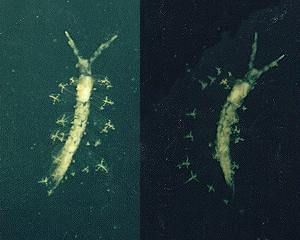
Hermaea cf. cruciata
Gould, 1870
Order: SACOGLOSSA
Superfamily: LIMAPONTIOIDEA
Family: Hermaeidae
DISTRIBUTION
Reported from the east coast of North America to Florida.
PHOTO
Santa Marta, Colombia (Caribbean coast). Photo: Phanor Montoya.
See Kathe Jensen's message discussing its identification.
Reference:
• Gould, A.A. (1870). Report on the Invertebrata of Massachusetts. Second edition, comprising the mollusca. Edited by W.G. Binney. Boston, v(3) plus 524 pp., text figs. 350-754, coloured pls. 16-27 comprising figs. 214-349
Rudman, W.B., 2000 (October 19) Hermaea cf. cruciata Gould, 1870. [In] Sea Slug Forum. Australian Museum, Sydney. Available from http://www.seaslugforum.net/find/hermcfcruc
Related messages
Re: Unknown from the Caribbean
October 20, 2000
From: Kathe R. Jensen
Dear Phanor & Bill,
I am almost certain that this species is a sacoglossan of the genus Hermaea. The rhinophores appear to have a small "knob" subterminally, indicating that the rolled part of the rhinophores ends here. In the Caribbean there are 2 possibilities: H. cruciata Gould, 1870, which has been recorded from the east coast of North America to Florida, and H. coirala Marcus, 1955, described from Brazil. H. cruciata has exactly the pale "cross-like" glands at the tips of the cerata as shown in these photos, but usually there are distinct, pink tubules of the digestive gland in the cerata as well as in the body. The colouration of H. coirala was described as transparent with brownish digestive gland. I think there is a good possibility the two names are one and the same species, the brown or pale colouration indicating starvation.
Best wishes,
Kathe
jensen@ait.ac.th
Jensen, K.R., 2000 (Oct 20) Re: Unknown from the Caribbean . [Message in] Sea Slug Forum. Australian Museum, Sydney. Available from http://www.seaslugforum.net/find/3213Thanks Kathe,
I hope its name turns out to be 'cruciata', it would be most appropriate.
Bill Rudman.
Re: Unknown from the Caribbean
October 20, 2000
From: Juan Lucas Cervera
Dear Bill,
It seems to me that this species could be Hermaea bifida or some related species. The shape of the rhinophores is like in this species, moreover the branching of the digestive gland at the top of the cerata.
Cheers.
Lucas.
lucas.cervera@uca.es
Cervera, J.L., 2000 (Oct 20) Re: Unknown from the Caribbean . [Message in] Sea Slug Forum. Australian Museum, Sydney. Available from http://www.seaslugforum.net/find/3214Thanks Lucas.
The vote is certainly in favour of Hermaea.
Bill Rudman
Unknown from the Caribbean
October 19, 2000
From: Phanor Montoya

Dear Bill:
I'm writing to you again. I found two of these organisms on a soft bottom (Depth 10ft)cover with Halophila sp seagrass [Santa Marta, Colombia - Caribbean coast]. The body is cream color and the cerata are completely translucid and have some kind of cross at the end of them. They were about 1 cm long. I have no idea what they can be, do you?
Phanor
phamont@eudoramail.com
Montoya, P., 2000 (Oct 19) Unknown from the Caribbean . [Message in] Sea Slug Forum. Australian Museum, Sydney. Available from http://www.seaslugforum.net/find/3099Dear Phanor,
I'm sorry but I can't see enough detail to be sure whether it is a sacoglossan or an aeolid. If it is an aeolid it is possibly a eubranchid, but really I have no idea what it is. Some one may recognise the very distinctive markings on the ceratal tips.
Best wishes,
Bill Rudman.
